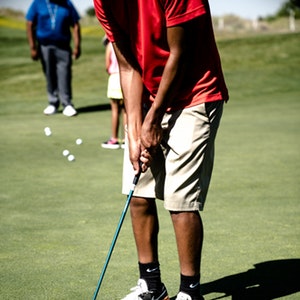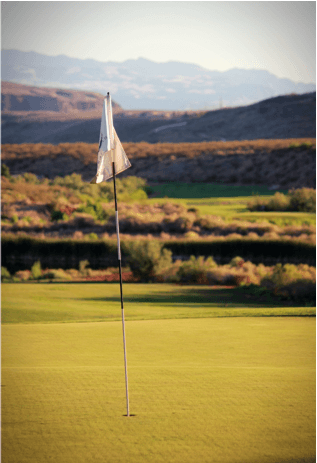Share this!
 By: Brian Neufeld, GolfTourney.com Contributor
By: Brian Neufeld, GolfTourney.com Contributor
In our last post, we covered some simple tips to improve your putting. Specifically, we focused on ways to improve your understanding of the green speed and break. These are the two most common areas where golfers struggle on the greens, but there are many more ways to shave strokes off your score with the flat stick in your hands. Below we’ll look at a few more ways to improve your putting.
Three-putt avoidance
One of the most underrated stats on the PGA tour is three-putt avoidance. While it’s easy to become enamored with driving distance and accuracy, three-putt avoidance will have a much larger impact on your final round score. Through mid-July of 2019, the top 20 tour pros in three-putt avoidance experience the three-jack less than two percent of the time. The leader in the stat, Wyndham Clark, has a total of 20 three-putts in 1,332 holes played.
The easiest way to lower your number of three-putts is to improve your lag putting. Like any discipline in golf, you must practice these often overlooked putts. Most of us hit the putting green, throw down three balls, and only work on putts from inside 10 feet. Try placing three balls around the 20-foot mark and once you’ve stopped all three within a putters length, move back to 30 feet. Do this all the way up to 50 feet and you should find improvement on the course with your lag putting. If you’re having trouble finding the right amount of power to give these long bombs, try changing where you look during the moment of impact. Looking at the target instead of your ball will help you judge the distance and speed of the longest putts. This takes some getting used to but is an excellent way to approach a 65-footer.
Statistical Analysis
Keeping score is as much a part of golf as swinging the club. A great way to improve your game without even lifting a club is to go beyond the hole score. You might think you’re putting well on a given day, but without any record-keeping, you’re just guessing. Scorecards typically have around eight rows to record scores, so take advantage of that extra space and start recording the number of putts you make on each hole. This will show you exactly how many three-putts you’ve had, and will help you direct your focus to problem areas when it’s time to hit the practice green. You can also make rows dedicated to fairways and greens hit to dial in your practice routine.
As with any area of play on the golf course, practice is your best friend. There are countless resources online to become a better putter, and an even larger number of practice drills. Instead of sticking to your normal 10 short putts on the green before you play, try incorporating some of these drills to your pre-round routine. You’re guaranteed to see improvement in your game when you invest some extra time, and the putting green is the best place to see that improvement in your round scores.
About the Author: Brian Neufeld
Brian Neufeld’s background includes more than 15 years of experience in golf course management, specializing in agronomy. Brian uses his knowledge of the game and best practices in turf sustention to create informative pieces for GolfTourney.com’s readers.
Share this!
Share this!
 By: Brian Neufeld, GolfTourney.com Contributor
By: Brian Neufeld, GolfTourney.com Contributor
In 2019, the USGA implemented a moderate amount of new rules for golf with a focus on improving the pace of play. While most charity or fundraising tournaments are played in a more relaxed manner and often under special rules, it’s important to stay up to date on the latest rule changes in case you find yourself in a more serious event. Many of golf’s new rules are favorable to the golfer, and we’ll cover a few of those here, as well as one not so helpful.
The most talked about rule change in golf this year is the ability to leave the flagstick in the cup while putting. Whether putting with the pin in is beneficial or not is sure to be debated for years to come. Many of us solo golfers have been putting with the pin in forever. However you feel about it, it’s bound to speed up rounds, and can’t hurt if you really like to power your putts to the hole.
One of the most underrated rule changes is ball drops no longer occur from shoulder height and can now be dropped from the knee. While this may seem like no big deal to some, I’m sure there are many others out there who have experienced horrible bounces from those high altitude ball drops. Especially for the taller golfer, this reduced drop height is sure to come in handy.
Speaking of dropping a new ball, one rule that is sure to hurt a lot of golfers is the reduced time to search for a lost ball. The old standard of five minutes has now been reduced to three. This is a big push to increase the speed of rounds but will undoubtedly increase scores for a large portion of the golfing population. May I suggest iron off the tee?
Another infraction off the rule book is grounding your club in a penalty area. This was a rule a lot of casual golfers are unaware of and one that could be interpreted maliciously with the wrong playing partner. You are also allowed to move loose impediments and touch the ground in penalty areas, so play from those areas will be fairer to the golfer.
These rule changes in golf will promote a more relaxed, casual feel to the average round. Tournament play should be impacted positively overall, with faster round times leading to a greater interest in the sport. Next time you’re out on the course, be sure to keep these changes in mind and use them to your advantage.
About the Author: Brian Neufeld
Brian Neufeld’s background includes more than 15 years of experience in golf course management, specializing in agronomy. Brian uses his knowledge of the game and best practices in turf sustention to create informative pieces for GolfTourney.com’s readers.
Share this!


